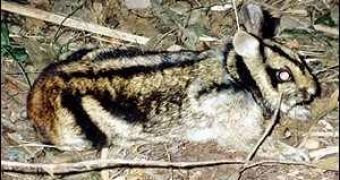This is the most mysterious bunny worldwide!
An unusual rabbit species inhabits only the Barisan Mountains in western Sumatra, one of the large islands of Indonesia.
It is the only rabbit in the region, also called Sumatran Striped Rabbit or the Sumatra Short-eared Rabbit.
Indeed, it is stripped and short eared and it is regarded as displaying the most beautiful coloration amongst all rabbits and hares.
As this little rabbit (just 40 cm or 1 ft, 4 in long) lives only in that area, it is critically endangered due to deforestation and habitat loss.
It inhabits forests at altitudes of 600-1400 meters and is nocturnal, resting during the day in burrows.
In fact, it is so rare that sightings of the species have only been reported three times since 1972, most recently in late January 2007 in a photograph taken with a camera trap in Bukit Barisan Selatan National Park, according to researchers from the Wildlife Conservation Society.
The first photo dates from 1998 in Kerinci Seblat National Park, and the second was taken in Bukit Barisan National Park in 2000.
Just 15 specimens from this species exist in museums, all from before 1929 and the species is currently assessed as 'Critically Endangered' by the World Conservation Union (IUCN).
"This rabbit is so poorly known that any proof of its continued existence at all is great news and confirms the conservation importance of Sumatra's forests," said Colin Poole, Director of the Wildlife Conservation Society's Asia Program.
This rabbit was believed to the only species of its genus, Nesolagus netscheri.
But in 1999, however, scientists found another Nesolagus species in the Annamite Mountains, between Laos and Vietnam (Nesolagus timminsi).
The two species look similarly, but genetic analyses showed that Sumatran and Annamite striped rabbits are separate species, even if closely related and they might have split off for approximately 8 million years.
The researchers didn't find stripped eggs or baskets on the rabbits' habitat...

 14 DAY TRIAL //
14 DAY TRIAL //